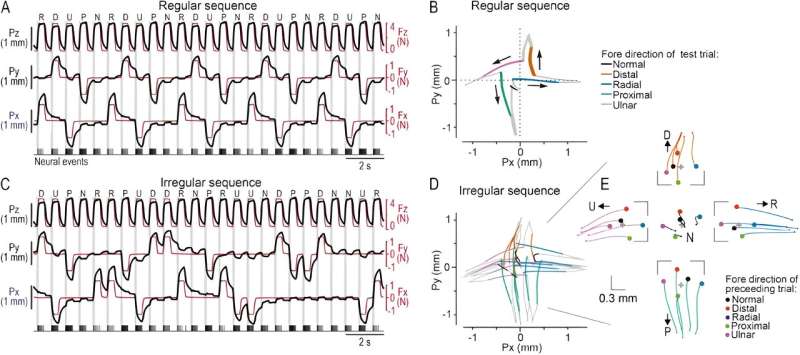This article has been reviewed according to Science X's editorial process and policies. Editors have highlighted the following attributes while ensuring the content's credibility:
fact-checked
peer-reviewed publication
trusted source
proofread
Scientists decipher the fingertip's 'memory'

Scientists have detailed how the activity of tactile neurons in the fingertip in response to an applied force is influenced by the fingertip's mechanical memory of previous forces.
The study, published today as an eLife Reviewed Preprint, provides what the editors call fundamental findings on how the fingertip's viscoelasticity—its time-dependent mechanical response to an applied force—affects the information relayed by tactile neurons to the brain.
The findings emphasize that these neurons not only signal current fingertip force but also the fingertip's viscoelastic memory of previous loadings. Tactile information about the recent physical state of the skin may help the brain to formulate accurate motor commands to control the hands in object manipulation and haptic tasks.
Everyday tasks we complete with our hands, such as cooking, cleaning, or grasping and transporting objects, require precise and rapidly recurring application of forces to external objects. To effectively accomplish these tasks, the brain relies on information about the forces acting on the fingertips provided by tactile neurons. However, these neurons do not directly signal contact forces; rather, they relay information about the deformations made to the skin by the applied force.
"The viscoelasticity of the human fingertip means that any deformation caused by a force acting on the fingertip lasts longer than the force itself," explains lead author Hannes Saal, Senior Lecturer in the Department of Psychology, University of Sheffield, UK. "Therefore, residual deformations from previous forces will affect how the fingertip reacts mechanically when subjected to a new force. However, the extent to which this physical memory influences the signaling of tactile neurons during natural hand use is not well understood."
To investigate this, Saal and colleagues examined how previous fingertip forces affected the responses of first-order tactile neurons when new forces were applied. They used a custom-built robot to stimulate the fingertip with forces that mimicked those typically encountered during natural object interaction.
They recorded impulse responses of nearly 200 individual neurons using specially designed electrodes inserted into peripheral nerves of human volunteers. The neurons were categorized as fast-adapting type 1 (FA-1), slowly-adapting type 1 (SA-1), and slowly-adapting type 2 (SA-2).
Forces were applied in different directions to the fingertip in rapid succession. By comparing fingertip deformation and elicited neural responses in stimulation sequences where the directional order of the stimuli was kept constant with sequences where the order was systematically varied, the team analyzed effects of the previous force stimulus on the responses of the subsequent one.
First, they noted that varying the loading history resulted in greater variation in fingertip deformation, confirming the viscoelastic memory of the fingertip. Then, they examined whether this increased variability in deformation was mirrored in the responses of the neurons. They found that firing rates during the force applications showed roughly twofold greater variability in FA-1 and SA-1 neurons, and around 70% more variability in SA-2 neurons, when the directional order was varied compared to fixed.
This indicated that the fingertip's viscoelastic memory influenced the responses in the tactile neuron. The difference in effect size between neuron types could stem from type 1 neurons primarily sensing mechanical events in the superficial structures of the skin, while type 2 neurons primarily sense tension states in deeper tissues.
Next, the team investigated whether the increased neuronal response variability could be linked to the fingertip's viscoelastic memory. To this end, they quantified the information relayed to the brain about the direction of the force, both the current and the previous one. They found that information about the current force direction decreased when the preceding stimulus was systematically varied as compared to when it was consistent.
Intriguingly, they also observed considerable diversity in the behavior of individual neurons within each type: while some neurons primarily signaled information about the current force direction, others signaled both the current and previous direction, and some primarily the preceding direction. Moreover, they discovered that SA-2 neurons, many of which are active even without external stimulation, could signal information about the fingertip's viscoelastic deformation state even between fingertip loadings.
This diversity of responses suggests that, collectively, first-order tactile neurons relay rich information about the fingertip's viscoelastic state to the brain, containing within them a memory of past stimulation. Co-author Ingvars Birznieks, Associate Professor at the University of New South Wales Sydney, states, "I am very compelled by the idea that one of the functions of SA-2 neurons might be to signal the overall viscoelastic state of the fingertip, which might enable more accurate interpretation of type-1 neuron input."
The authors note that there has been no systematic investigation into whether effects of viscoelasticity on tactile sensing impact the performance of manual tasks, so it remains unclear whether viscoelasticity might limit performance, or if the neural information about past stimuli is used by the brain in some capacity. Additionally, as proposed in the eLife public review, the study could gain from a more direct examination of the link between skin deformation and neuron firing, a facet that the authors are currently addressing.
"Our findings suggest that populations of tactile neurons provide a continuous stream of information to the brain about the viscoelastic deformation state of the fingertip," concludes senior author Roland Johansson, Professor in the Department of Integrative and Medical Biology, Umeå University, Sweden. "It is plausible that the brain employs this information to estimate the fingertip's state during the planning and evaluation of tactile-based actions. Investigating this idea in future research holds intriguing potential."
More information: Hannes P. Saal et al, Memory at your fingertips: how viscoelasticity affects tactile neuron signaling, eLife (2023). DOI: 10.7554/eLife.89616.1





















